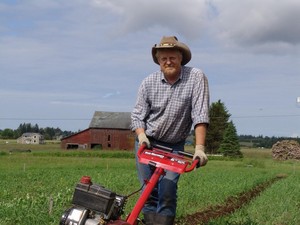21 Feb Mon 2011
Requiring Carbon Emission Data From the Supply Chain
I came across a very interesting article fromThe National Hog Farmer, online date Feb. 18, 2011. Here is the link: http://license.icopyright.net/user/viewContent.act?clipid=605476612&mode=cnc&tag=3.5492?icx_id%3Dnationalhogfarmer.com/environmental-stewardship/consumers-demand-environmental-data-0215/index.html
In this article, a new trend is reported of shifting accountability down the supply chain to primary producers. Even though consumers are said to be driving this trend, the real driver isWal-Mart, which controls 29% of the retail food market in the United States (Kroger - parent company of Fred Meyer - is #2 at 8% and the rest carve up the remaining market share). Since Wal-Mart is the largest customer for the major food companies (like Kraft, Pepsico, etc.), anytime Wal-Mart institutes a program, these companies have to respond.
In a June 2010 shareholders' meeting, Wal-Mart's president and CEO Mike Duke, committed to a reduction of 20 million metric tons (22 million tons) of greenhouse gas emissions by 2015. However, he said this would come from the supply chain. For anyone who knows how Wal-Mart works, this should come as no surprise. Since Wal-Mart has tremendous sales and marketing "muscle," it can dictate how products are palletized, presented and even manufactured. By demanding reduction in greenhouse gas emissions from its suppliers, Wal-Mart can effectively control how food is produced.
The first step in this process istracking emissionsand Wal-Mart has successfully co-opted the word "transparency" for this program. Major food companies are balking (no surprise here!), but Wal-Mart is effectively showing them how to do it by instituting the tracking in their private brands. Once the Wal-Mart private brands have this information on their packaging, there will be no excuse for the major food companies not to follow suit. It should also be noted that, just as the invention of Lotus 1-2-3 set the template for other accounting spreadsheets like Excel, so too the way Wal-Mart institutes greenhouse gas emissions tracking will become the default method. This is a game-changer, by the way, just as Lotus 1-2-3 changed the way accounting is done in the United States (and probably worldwide too, for all I know!).
The economic effect this will have on producers is painfully obvious. As Eric Jackson, one of the sources in the article says, "Eventually, participation in the market is going to be limited by whether or not you are willing to provide information to your downstream markets. . . . Right now, it is all about measurement." Later in the article, Jackson comments on the nonvoluntary nature of providing this information, "The consumer will eventually start making data-driven choices; that's probably only 5-10 years away. If there are any gaps the industry is not covering, the regulators will fill in the gaps." For those of you cognizant of the Food Modernization Act passed last November (usually referred to as SB 510 in the discussions previous to its passage), this sweeping reform of food production regulations fits in well with supply chain regulation by Wal-Mart and other food retailers. It all fits together quite nicely, doesn't it? Almost as if it was planned that way. (!)
Finally, Jackson has a word of advice for producers, "Watch for the metrics being set for measuring and categorizing greenhouse gas emissions and have the tools necessary to respond to these metrics." This sounds a bit like my use of calories to measure energy inputs and outputs doesn't it? Is it possible that our corporate masters actually understand what is really going on in our post-peak oil world? It is not only possible, it is likely they not only understand what is really going on, but alsohow to co-opt itfor their own nefarious ends.
Focusing on greenhouse gas emissions allows corporations, governments, and academia to use a very cumbersome method of cost accounting that has value in the aggregate, but is near impossible to utilize on a small-scale, individualized basis. Not only does it take a lot of infrastructure to keep track of many industries, but the sheer scale of measurement adds its own problems. For example, in Sweden, kilograms of carbon needed to produce a food item is prominently displayed on the food packaging. This is touted as leading edge transparency. However, the numbers are based on overall industry averages, so they do not take into account differing production methods; for instance tractor agriculture versus hand labor methods, or packing for a farmers market versus packing to be sent across country on trucks. In addition, focusing on a waste stream - greenhouse gas emissions - is a "second-order" measurement, versus the "primary-order" measurement of energy used in actual production; e.g. calories used to power the tractor, not just a measurement of the smoke coming from the tractor. Indeed, it is likely that focusing on greenhouse gas emissions distorts the true environmental cost of what is produced. Thus, for all you conspiracy buffs out there, there seems to be a "channeling effect" in using greenhouse gas emissions as a measure of environmental cost, one thatunderstatesthe damage done.
There are two main points to my review of this article. First, Wal-Mart is driving a move among retailers to shift accountability onto producers, which can then be regulated by their federal government cronies. Secondly, we don't really have to buy into this if we don't buy from food retailers. This last point was not explicitly stated in my review, but I assume you could recognize it as the "elephant in the argument."


Perfectly put! Now if we can just get consumers to understand the reality of, well REALITY, we will be getting somewhere!
Meg